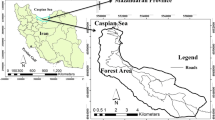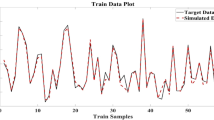Abstract
Forests, with natural factors, provide visual aesthetic features, as a social ecosystem service for human beings. Nowadays, forest managers are looking for decision support system tools which evaluate the aesthetic quality of forest landscapes, particularly in the development of human ecosystem services. In our methodology, the aesthetic quality of environment is assessed with a human-perception-based approach to apply three machine learning techniques (support vector machine (SVM), radial basis function neural network (RBFNN) and multilayer perceptron (MLP)) for the aesthetic quality simulation of forest areas. To perform this method, the landscape attributes (13 features) were defined in 72 Hyrcanian broad leaves forest landscapes. The landscapes aesthetic quality model was designed to determine the visual qualities by machine learning techniques. Considering the results, MLP model was detected as the most practical, reliable and accurate model for evaluation of landscape quality in broad leaves forest areas. Comparing to RBFNN (R2 = 0.809), and SVM (R2 = 0.829), MLP (R2 = 0.878) model represents the most reliable results of R2 in the test data set. The number of species, tree density, Alnus subcordata, canopy density, altitude and Carpinus betulus in forest areas were detected as the main influential factors of the MLP model. On the other hand, the designed graphical user interface tool finds the most scenic landscapes for peoples who are looking for relaxation and recreation services in the nature. The forested lands planted according to the ecological techniques could be designed with resulted aesthetics criteria.












Similar content being viewed by others
Data availability
The data that support the findings of this study are available from the corresponding author upon reasonable request.
Abbreviations
- MLP:
-
Multilayer perceptron
- RBFNN:
-
Radial basis function neural network
- SVM:
-
Support vector machine
- ANN:
-
Artificial neural network
- EDSS:
-
Environmental decision support system
- GUI:
-
Graphical user interface
- MSE:
-
Mean squared error
- RMSE:
-
Root mean squared error
- MAE:
-
Mean absolute error
- LM:
-
Levenberg–marquardt
- GIS:
-
Geographic information system
- DBH:
-
Diameter at the breast height
References
Aboufazeli S, Jahani A, Farahpou M (2021) A method for aesthetic quality modelling of the form of plants and water in the urban parks landscapes: an artificial neural network approach. MethodsX 8:101489
Aghajani H, Marvie Mohadjer MR, Jahani A, Asef MR, Shirvany A, Azarian M (2014) Investigation of affective habitat factors affecting on abundance of wood macrofungi and sensitivity analysis using the artificial neural network (case study: Kheyrud forest). J Forest Poplar Res 21(4):617–628
Azadeh A, Ghaderi SF, Sohrabkhani S (2006) Forecasting electrical consumption by integration of Neural Network, time series and ANOVA. Appl Math Comput 186:1753–1761
Carvalho-Ribeiro S, Loupa Ramos I, Madeira L, Barroso F, Menezes H, Pinto Correia T (2013) Is land cover an important asset for addressing the subjective landscape dimensions? Land Use Policy 35:50–60
Daniel TC (2001) Whither scenic beauty? Visual landscape quality assessment in the 21st century. Landsc Urban Plan 54:267
Demuth H, Beale M (2002) Neural network toolbox for use with MATLAB ®. MathWorks, Inc. User’s Guide Version 4. p.840
Dupont L, Ooms K, Antrop M, Van Eetvelde V (2016) Comparing saliency maps and eye-tracking focus maps: The potential use in visual impact assessment based on landscape photographs. Landsc Urban Plan 148:17–26
Dwyer J, Schroeder H, Gobster P (2006) The significance of urban trees and forests: toward a deeper understanding of values. J Arboric 17(10):276–284
Ebenberger M, Arnberger A (2019) Exploring visual preferences for structural attributes of urban forest stands for restoration and heat relief. Urban Forest Urban Green. https://doi.org/10.1016/j.ufug.2019.04.011
Franco D, Franco D, Mannino I, Zanett G (2003) The impact of agroforestry networks on scenic beauty estimation: The role of a landscape ecological network on a socio-cultural process. Landsc Urban Plan 62:119–138
Frank S, Fürst C, Koschke L, Makeschin F (2012) A contribution towards a transfer of the ecosystem service concept to landscape planning using landscape metrics. Ecol Indic 21:30–38
Güngör S, Polat AT (2018) Relationship between visual quality and landscape characteristics in urban park. J Environ Prot Ecol 19(2):939–948
Haviland-Jones J, Rosario HH, Wilson P, Mcguire TR (2005) An environmental approach to positive emotion: flowers. Evol Psychol 3:104–132
Hong H, Tsangaratos P, Ilia I, Liu J, Zhu AX, Xu C (2018) Applying genetic algorithms to set the optimal combination of forest fire related variables and model forest fire susceptibility based on data mining models. The case of Dayu County, China. Sci Total Environ 630:1044–1056
Howley P (2011) Landscape aesthetics: assessing the general publics’ preferences towards rural landscapes. Ecol Econ 72:161–169
Hoyle H, Hitchmough J, Jorgensen A (2017) All about the “wow factor”? The relationships between aesthetics, restorative effect and perceived biodiversity in designed urban planting. Landsc Urban Plan 164:109–123
Jahani A (2019) Forest landscape aesthetic quality model (FLAQM): a comparative study on landscape modelling using regression analysis and artificial neural networks. J for Sci 65(2):61–69
Jahani A, Allahverdi Sh, Saffariha M, Alitavoli A, Ghiyasi S (2021a) Environmental modeling of landscape aesthetic value in natural urban parks using artificial neural network technique. Model Earth Syst Environ. 1–10
Jahani A, Hatef Rabiee Z, Saffariha M (2021b) Modeling and prediction of the aesthetics of urban parks based on landscape complexity criterion. J Nat Environ 74(1):27–40
Jahani A, Rayegani B (2020) Forest landscape visual quality evaluation using artificial intelligence techniques as a decision support system. Stoch Env Res Risk Assess 34(10):1473–1486
Kalantary S, Golbabaei F, Latifi M, Shokrgozar MA, Yaseri M (2020) Assessment of electrospinning antioxidant nanofibers in skin exposure to oxidative stress. J Mazandaran Univ Med Sci 30(186):68–79
Kalantary S, Jahani A, Pourbabaki R, Beigzadeh Z (2019) Application of ANN modeling techniques in the prediction of the diameter of PCL/gelatin nanofibers in environmental and medical studies. RSC Adv 9(43):24858–24874
Kalantary S, Pourbabaki R, Jahani A, Sadeghi Yarandi M, Samiei S, Jahani R (2021) Development of a decision support system tool to predict the pulmonary function using artificial neural network approach. Concurr Comput Pract Exp 33:62–58
Kao Y, Huang K, Maybank S (2016) Hierarchical aesthetic quality assessment using deep convolutional neural networks. Signal processing. Image Commun 47:500–510
Kaplan S (1995) The restorative benefits of nature: Toward an integrative framework. J Environ Psychol 15:169–182
Kerebel A, Gelinas N, Dery S, Voigt B, Munson A (2019) Landscape aesthetic modelling using Bayesian networks: conceptual framework and participatory indicator weighting. Landsc Urban Plan 185:258–271
Khaleghpanah R, Jahani A, Khorasani N, Goshtasb H (2019) Prediction model of citizens’ satisfaction in urban parks using artificial neural network. J Nat Environ 72(2):239–250
Laref R, Losson E, Sava A, Siadat M (2018) Support Vector Machine Regression for Calibration Transfer between Electronic Noses Dedicated to Air Pollution Monitoring. Sensors (Basel).1 18(11):3716. https://doi.org/10.3390/s18113716
Nordh H, Østby K (2013) Pocket parks for people—a study of park design and use. Urban Forest Urban Green 12:12–17
Palmer JF, Hoffman RE (2001) Rating reliability and representation validity in scenic landscape assessment. Landsc Urban Plan 54:149
Pourmohammad P, Jahani A, Zare Chahooki MA, Goshtasb Meigooni H (2020) Road impact assessment modeling on plant diversity in national parks using regression analysis in comparison with artificial intelligence. Model Earth Syst Environ 6(3):1281–1292
Quej VH, Almorox J, Arnaldo JA, Saito L (2017) ANFIS, SVM and ANN soft-computing techniques to estimate daily global solar radiation in a warm sub-humid environment. J Atmos Solar Terr Phys 155:62–67
Rafieepour A, Farasati F, Kalantari S, Motamedzadeh M, Rafieepour E (2014) Estimation of maximum aerobic capacity and the effect of demographic factors and personal habits on it in students of Hamadan university of medical sciences, Iran. Qom Univ Med Sci J 8(3):33–40
Ruskule A, Nikodemus O, Kasparinskis R, Bell S, Urtane I (2013) The perception of abandoned farmland by local people and experts: landscape value and perspectives on future land use. Landsc Urban Plan 115:49–61
Saeidi S, Mohammadzadeh M, Salmanmahiny A, Mirkarimi SH (2017) Performance evaluation of multiple methods for landscape aesthetic suitability mapping: a comparative study between multi-criteria evaluation, logistic regression and multi-layer perceptron neural network. Land Use Policy 67:1–12
Saffariha M, Azarnivand H, Zare Chahooki MA, Tavili A, Nejad Ebrahimi S, Potter D (2019) The effect of flowering on the quantity and quality of Salvia limbata in altitudes. J Range Watershed Manag 72:139–149
Saffariha M, Jahani A, Jahani R, Latif S (2021) Prediction of hypericin content in Hypericum perforatum L. in different ecological habitat using artificial neural networks. Plant Methods 17(1):1–17
Sagheb Talebi K, SSajedi T, Yazdian F (2003) Forests of Iran. Research Institute of Forests and Rangelands Press, p 28
Sahraoui Y, Clauzel C, Foltete JC (2016) Spatial modelling of landscape aesthetic potential in urban-rural fringes. J Environ Manage 181:623
Shams SR, Jahani A, Kalantary S, Moinaddini M, Khorasani N (2021) Artificial intelligence accuracy assessment in NO2 concentration forecasting of metropolises air. Sci Rep 11(1):1–9
Shirani Sarmazeh N, Jahani A, Goshtasb H, Etemad V (2017) ecological impacts assessment of recreation on quality of soil and vegetation in protected areas (case study: Qhamishloo national park and wildlife refuge). J Nat Environ 70(4):881–891
Shuaib AA, Enoch OF (2013) Application of kelantan traditional aesthetic values into the architecture of contemporary homes. Arts Des Stud 6:15–25
Simensen T, Halvorsen R, Erikstad L (2018) Methods for landscape characterisation and mapping: a systematic review. Land Use Policy 75:557–569
Smith A (2008) Aesthetic value and visual resources management in British Colombia's community forests. Thesis in master of resource management in Brock University. Canada, vol 133
UNESCO. World Heritage List. Hyrcanian Forests. (2019)
Wang R, Zhao J, Meitner MJ, Hu Y, Xu X (2019) Characteristics of urban green spaces in relation to aesthetic preference and stress recovery. Urban Forest Urban Green 41:6–13
Wang L, Ngan HYT, Yung NHC (2018) Automatic incident classification for large-scale traffic data by adaptive boosting SVM. Inf Sci 467:59–73
Wang R, Zhao J, Meitner MJ (2017) Urban woodland understory characteristics in relation to aesthetic and recreational preference. Urban Forest Urban Green 24:55–61
White M, Smith A, Humphryes K, Pahl S, Snelling D, Depledge M (2010) Blue space: the importance of water for preference, affect, and restorativeness ratings of natural and built scenes. J Environ Psychol 30:482–493
Wu Y, Bishop I, Hossian H, Sposito V (2006) Using GIS in landscape visual quality assessment. Appl GIS 2(3):1–20
Yusefi GH, Faizolahi K, Darvish J, Safi K, Carlos Brito J (2019) The species diversity, distribution, and conservation status of the terrestrial mammals of Iran. J Mammal 100(1):55–71
Acknowledgements
We thank the manager of Khyrud Forest who support us in field survey.
Funding
The authors have not disclosed any funding.
Author information
Authors and Affiliations
Corresponding author
Ethics declarations
Conflict of interest
The authors declare no conflict of interest.
Additional information
Publisher's Note
Springer Nature remains neutral with regard to jurisdictional claims in published maps and institutional affiliations.
Supplementary Information
Below is the link to the electronic supplementary material.
Rights and permissions
Springer Nature or its licensor (e.g. a society or other partner) holds exclusive rights to this article under a publishing agreement with the author(s) or other rightsholder(s); author self-archiving of the accepted manuscript version of this article is solely governed by the terms of such publishing agreement and applicable law.
About this article
Cite this article
Jahani, A., Saffariha, M. & Barzegar, P. Landscape aesthetic quality assessment of forest lands: an application of machine learning approach. Soft Comput 27, 6671–6686 (2023). https://doi.org/10.1007/s00500-022-07642-3
Accepted:
Published:
Issue Date:
DOI: https://doi.org/10.1007/s00500-022-07642-3




